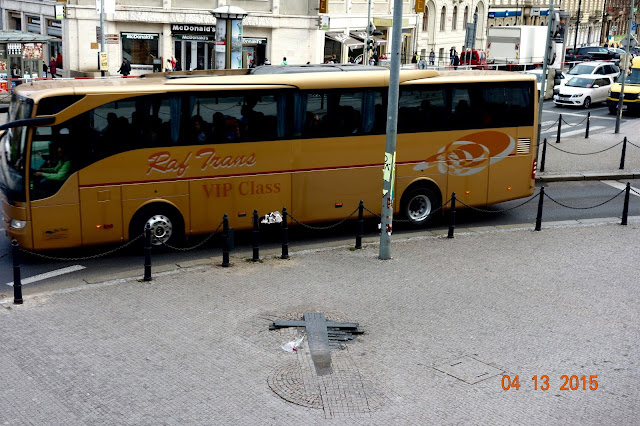Wenceslas Square is more like a long boulevard. The site of a former horse market, it's named after the patron saint of Bohemia.
The main building of the National Museum, sits directly behind the statue of St. Wenceslas. It's closed for renovation until at least 2018.
Wenceslas Square runs into the old town. Sanitation workers were cleaning up after some kind of celebration that included a lot of balloons, ribbons and flowers.
It's hard not to be enchanted by Prague even if it does sometimes seem like a Disneyesque riff on Mittel Europa. Taking pretty pictures is like shooting fish in a barrel, even with much of the city under reconstruction.
The city fathers aren't shy about mixing up the new with the old, either. Take, for example, this hussy kneeling in front of a classic building.
The Spanish Synagogue was my first stop in Josefov, which is completely surrounded by the old town.
When the Holy Roman Emperor Josef II opened Prague to Jews in 1781, they were so grateful that they named their ghetto after him. In an attempt to make Prague more like Paris at the end of the 19th century, much of Josefov was torn down but a few synagogues survived. The Spanish Synagogue is by far the most beautiful.
The synagogue does a good job of documenting Prague's substantial Jewish history, including the anti-Semitism that preceded Nazi annexation. This cartoon depicts a Jew fleeing to America to escape socialism. With bags of money, of course.
But the Nazis were more determined in their expression of anti-Semitism.
They seized religious garb as well as silver when they rounded up Jews before sending them to Terezin, what they called a "model Jewish settlement" in a propaganda film.
The Old-New Synagogue was a short walk away.
While not as beautiful as the Spanish Synagogue and much smaller, the Old-New Synagogue has been central to Jewish life in Prague for more than seven centuries, and is the oldest active synagogue in Europe.
A quick visit to the Ceremonial Hall taught me more than I ever knew about Jewish burial rites. Many of the implements used at this former mortuary, built next door to the Jewish cemetery in the early 20th century, also were on display.
I took a break from Jewish history and hurried back to old town square to watch the astronomical clock strike noon.
The 12 apostles made an appearance.
On the way back to Josefov, I passed the ghost of Franz Kafka in a souvenir shop. More on Franz later. I can't decide if he or Vaclav Havel is Prague's favorite son.
The lovingly restored Klausen Synagogue is Josefov's largest.
Jewish stars were embedded everywhere in the synagogue's design.
Many people used guides to better understand the permanent exhibit of Jewish customs and traditions.
Here's a bris kit. Mohels use it to circumcise male babies. Unfortunately, this also made it easier for the Nazis to identify Jewish men who were trying to escape persecution.
The Pinkas Synagogue around the corner included a Holocaust memorial.
A heartbreaking exhibit upstairs includes the luggage of children who were sent to Terezin, called Theresienstadt by the Nazis, a kind of purgatory for Czech Jews. If they didn't die in this settlement, they were deported to concentration camps in other parts of Eastern Europe.
More than 15,000 children passed through the camp. Some of their drawings are displayed.
I saved the Old Jewish Cemetery for last. Beginning in 1439, nearly 12,000 Jews were buried during here during the next 350 years in an area the size of a single city block. If it seems small, that's because as many as ten graves are layered on top of one another.
Spotting an orthodox Jew in New York hardly would be worth taking a photo, but in Josefov, now mostly occupied by luxury retailers, it was like seeing an endangered species in the wild.


























































































































No comments:
Post a Comment